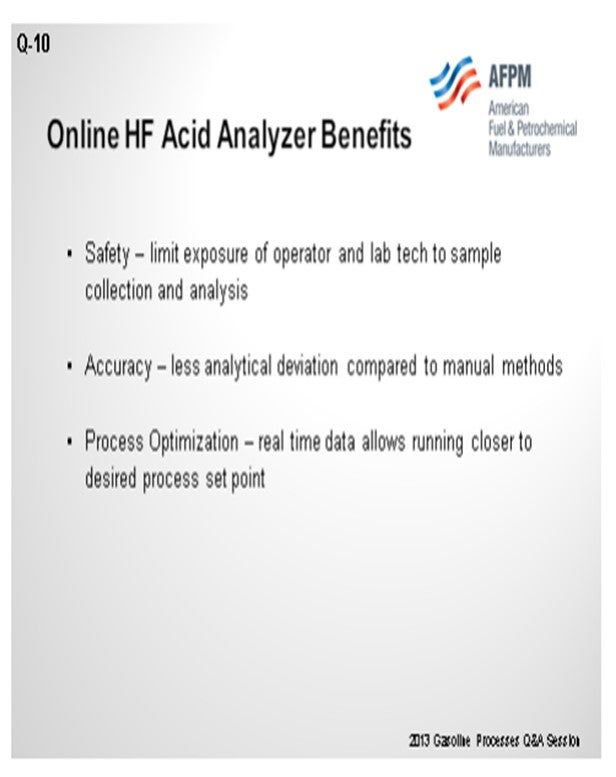Question 10: What is the industry experience with continuous online acid strength analyzers in HF and sulfuric acid services? Please comment on accuracy and reliability.
BULLEN (UOP LLC, A Honeywell Company)
Again, I will address the HF units. UOP is aware of two vendors who are marketing online analyzers for percent HF and percent water. The experience of their customers has been generally positive. These analyzers give continuous readings, so you can detect issues much faster. However, these types of analyzers still need to have calibration, which means that you will have to at least run monthly samples to make sure the analyzer is tracking the right condition.
We have had some refiners use a simple conductivity analyzer to provide a percent water and then circulate that HF as a general trend. This can work, but you can have other components actually make the conductivity change. So just be aware. And again, you need to take backup samples to check the levels to avoid getting into trouble.
MELDRUM (Phillips 66)
The initial NIR (near infrared spectroscopy) online HF analyzer was developed by Phillips Petroleum Company and later offered by ABB. This analyzer was first demonstrated in our Sweeny Refinery in the early 2000s. The benefits of online acid analysis include safety, accuracy – meaning more repeatability, and opportunities for process optimization. The safety benefits come from having fewer manual samples, which limit operator exposure from sample collection, and less exposure to the laboratory technician during the analysis of the acid. The repeatability has less analysis deviation compared to manual methods, and the process optimization opportunities come from having real-time data allowing us to run closer to our desired process set points.
Since this initial analyzer is based on NIR technology, Invensys has entered the market with an analyzer which was also demonstrated at the Sweeny Refinery in 2009. Acid properties are determined by correlation: using density to correlate to acid strength and conductivity correlated to acid water. The analyzer has a lower cost than the initial NIR analyzer and maintenance requirements. Phillips 66 has installed Invensys analyzers in four locations and the NIR-type analyzer at two locations. I understand that ABB is now offering a TALYS NIR system, reported to be about 50% the cost of their original NIR system. I also want to mention that we tried, without success, using an analyzer based on refractive index technology. Sulfuric acid analysis using Coriolis meters is proven in common practice on the sulfuric alkylation units.

PUI-NANG LIN (Flint Hills Resources, LP)
We have very good experience with these NIR-type analyzers on acid purities. We tried to do a calibration check with the lab samples. Most of the time, the problem is getting a full sample from our sampling collection system. The analyzer actually gave us lower results, but we do find that the NIR typically gives us positive bias versus the lab results. I wonder if anyone has had that same experience.
ROBERTSON (AFPM) Since there are no other comments, Pui-Nang, I suggest that you take that question to the P&P this afternoon and see if you can get an answer there.
PATRICK BULLEN (UOP LLC, A Honeywell Company)
We are aware of two vendors who are currently marketing online analyzers for HF acid strength water. In general, the experience has been positive. The analyzers provide a continuous reading for HF strength and the percentage of water, so changes can be detected much faster. It is still necessary to periodically take HF samples and analyze them in the laboratory in order to keep both types of analyzers calibrated. So the number of acid samples that must be taken to the laboratory can be significantly reduced, but the analysis of acid samples in the laboratory cannot be eliminated completely. Laboratory analysis of one to two acid samples per month appears typical for HF units with an online acid analyzer.
A few refiners have installed simple conductivity analyzers that provide an indication of the percentage of water in the circulating HF. These standalone conductivity analyzers can be useful to show sudden water upsets, but there are components other than water content that can change the conductivity reading. Lower HF strength or an increase in certain feed contaminants can cause higher conductivity readings.
CRAIG MELDRUM (Phillips 66)
The initial FT-NIR (Fourier Transform-Near Infrared) online HF acid analyzer was developed by Phillips Petroleum Company and ABB and installed at the Sweeny refinery in early 2000s. The benefits of online acid analysis include:
• Safety: fewer manual samples which limit operator exposure from sample collection and lab tech exposure from sample analysis,
• Accuracy: less analysis deviation compared to manual methods, and
• Process optimization, because real-time data allows running closer to desired process setpoint (water and acid strength) and reduced lab costs.
Invensys entered the market with an analyzer, which was also demonstrated at the Sweeny refinery in 2009. Acid properties are determined by correlation using density correlated to acid strength and conductivity correlated to acid water. This analyzer is a lower-cost option to the FT-NIR analyzer and requires less maintenance. P66 has Invensys analyzers installed at four locations and FT-NIR analyzers at two locations.
ABB now offers a TALYS NIR system reported to cost about 50% of its original FT-NIR. We also tried, without success, an analyzer that used refractive index technology. Sulfuric acid analysis using Coriolis meters is proven and a common practice on sulfuric acid alkylation units